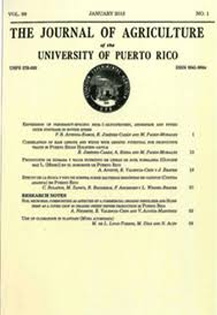Abstract
Nitrogen (N) is possibly the most limiting nutrient for crop production on the southern semi-arid coast of Puerto Rico. In efforts to improve inbred maize (Zea mays L.) grain yield, fertilizer N is sometimes aggressively managed. In this paper, we report on the results of a field experiment that evaluated the effect of six rates of fertilizer N (0, 34, 68,102,135 and 203 kg N/ha) and of cowpea (Vigna unguiculata cv. Iron-clay), planted as a cover crop during the offseason, on inbred maize grain yield. The soil was Jacaguas series (Loamy-skeletal, mixed, superactive, isohyperthermic Fluventic Haplustolls) on the Dow Agrosciences experimental farm in Santa Isabel, Puerto Rico. Cowpea was planted on 13 July 2013 and incorporated into the soil on 20 September 2013. An inbred maize line was planted on 19 December 2013 and harvested on 19 March 2014 at a plant density of 51,645 plants per hectare. Irrigation was provided via drip system, and fertilizer N was applied at three different stages during the growing season: at emergence, 21 and 37 days after planting. Measurements of plant height, chlorophyll readings using SPAD-502® and GreenSeeker®, and leaf N concentration were used as indicators of treatment response and N sufficiency. The maximum grain yield of 2,918 kg/ha was attained with the fertilizer N rate of 68 kg N/ha. The cowpea cover crop rotation did not affect grain yield (P>0.05). Plant height, and measurements by SPAD-502® and GreenSeeker® provided adequate indicators of crop N sufficiency during the vegetative stages V6 to V12, with optimum values of 149 cm, 46, and 0.67 NDVI, respectively, 52 days after planting with an application of 68 kg N/ ha. Crop response to fertilizer N occurred at a lower rate than in previous studies and those occurring under conventional commercial conditions. Other factors related to fertilizer N management, such as sources, placement and timing of application might be as important for grain yield improvement of inbred maize.

